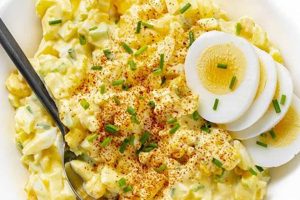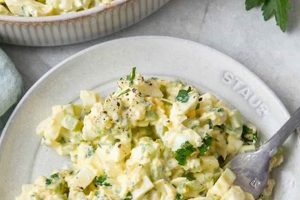Combinations of cooked eggs and various salad ingredients represent a versatile and nutritious meal option. A simple preparation might involve sliced hard-boiled eggs atop mixed greens with a vinaigrette. More complex versions incorporate chopped eggs into mayonnaise-based dressings, combined with ingredients such as celery, onion, and relish, or feature eggs as a key component in composed salads like a classic Cobb or Nicoise. Such dishes offer diverse textures and flavors, easily adaptable to individual preferences.
These culinary creations offer a readily available source of protein and essential nutrients. Historically, eggs have been a dietary staple, and their inclusion in salads provides a satisfying and economical way to enhance nutritional value. The adaptability of egg salads lends itself to various cultural interpretations and dietary needs, making them a popular choice for quick lunches, picnics, and light meals. Their simplicity also makes them ideal for novice cooks while offering experienced chefs a platform for creative culinary expression.
Further exploration will delve into specific variations, nutritional information, tips for preparation and storage, and suggestions for ingredient substitutions to accommodate dietary restrictions and preferences.
Tips for Preparing Egg Salad
Creating a flavorful and visually appealing egg salad requires attention to detail. These tips offer guidance for achieving optimal results.
Tip 1: Perfect Hard-Boiled Eggs: Avoid overcooking eggs, which can result in a rubbery texture and a green ring around the yolk. Gently simmer eggs for 8-10 minutes, then immediately transfer them to an ice bath to stop the cooking process.
Tip 2: Precise Chopping: Uniformly chopped ingredients ensure a pleasant texture and even distribution of flavor. A sharp knife and a consistent chopping motion are crucial.
Tip 3: Balanced Seasoning: Salt and pepper are essential, but consider incorporating other seasonings such as paprika, mustard powder, or dill for added complexity. Taste and adjust seasonings gradually.
Tip 4: Mayonnaise Mastery: The quality and quantity of mayonnaise significantly impact the final product. Start with a small amount and add more as needed, avoiding an overly creamy or bland result. Experiment with different types of mayonnaise, such as flavored or reduced-fat options.
Tip 5: Textural Variety: Incorporating ingredients like finely diced celery, red onion, or chopped pickles adds a welcome textural contrast to the creamy egg base.
Tip 6: Fresh Herbs Enhancement: Fresh herbs like chives, parsley, or tarragon elevate the flavor profile. Add them just before serving to maintain their vibrancy.
Tip 7: Proper Storage: Refrigerate egg salad promptly and consume it within 3-5 days. Store it in an airtight container to prevent it from absorbing odors from other foods.
Following these guidelines ensures a delicious and satisfying egg salad experience, maximizing flavor and texture while maintaining food safety standards.
These practical tips provide a solid foundation for crafting exceptional egg salads. Experimentation with various ingredients and flavor combinations allows for personalized creations.
1. Ingredient Selection
Ingredient selection significantly impacts the overall flavor, texture, and nutritional value of egg salad. Careful consideration of individual components ensures a balanced and enjoyable culinary experience. The quality and freshness of ingredients directly influence the final product.
- Eggs:
The foundation of any egg salad lies in the quality of the eggs. Fresh, high-quality eggs contribute to both flavor and texture. Proper cooking techniques, such as avoiding overcooking, are essential for achieving the desired consistency. Free-range or organic options offer potential nutritional advantages.
- Binding Agents:
Mayonnaise is the traditional choice, but variations exist. Greek yogurt, avocado, or hummus offer healthier alternatives with distinct flavor profiles. The quantity of the binding agent influences the creaminess and overall texture. Homemade mayonnaise allows for customized flavor combinations.
- Aromatics and Vegetables:
Ingredients such as celery, red onion, chives, and bell peppers introduce textural and flavor complexity. Finely dicing these components ensures even distribution and enhances the sensory experience. The choice of aromatics influences the overall flavor profile, from classic to innovative.
- Seasonings and Flavor Enhancers:
Salt, pepper, mustard, paprika, dill, and other herbs and spices contribute depth of flavor. Balancing these elements is crucial to avoid overpowering the delicate egg flavor. Freshly ground spices offer superior flavor compared to pre-ground options.
The interplay of these ingredient categories determines the final character of the egg salad. A thoughtful approach to ingredient selection elevates a simple dish into a culinary creation. Experimentation with various combinations allows for personalized flavor profiles and caters to individual dietary needs and preferences.
2. Egg Preparation Methods
Egg preparation methods significantly influence the final texture, flavor, and overall quality of egg salad. Selecting the appropriate method depends on the desired outcome and recipe specifics. Understanding the nuances of each technique ensures optimal results.
- Hard-Boiling:
The most common method for egg salad, hard-boiling involves submerging eggs in simmering water for a specific duration. Proper timing prevents overcooking, which can lead to a rubbery texture and an undesirable sulfurous odor. An ice bath immediately following cooking halts the process and ensures easy peeling. Hard-boiled eggs provide a firm texture suitable for chopping and slicing.
- Soft-Boiling/Poaching:
While less frequently used in traditional egg salad, soft-boiled or poached eggs offer a creamier, richer texture. These methods involve cooking eggs in simmering water for a shorter time, leaving the yolk runny or partially set. Incorporating soft-boiled eggs into an egg salad creates a smoother, more decadent consistency. This approach is suitable for those who prefer a less traditional, more luxurious egg salad.
- Scrambled/Fried:
Scrambled or fried eggs, while unconventional, can introduce unique textural and flavor elements to egg salad. The method involves cooking eggs in a pan with fat, resulting in a softer, more fragmented texture. This approach offers an alternative to the traditional chopped hard-boiled egg and provides a distinct flavor profile. This method may appeal to individuals seeking a departure from traditional egg salad recipes.
- Baking:
Baking eggs in the oven offers a hands-off approach to cooking, resulting in evenly cooked whites and yolks. This method is particularly suitable for preparing a large quantity of eggs for egg salad. Baked eggs offer a firm yet tender texture, suitable for chopping or slicing.
The chosen egg preparation method directly impacts the final character of the egg salad. From the classic hard-boiled egg to the less conventional baked or scrambled options, each technique offers a unique contribution to the overall culinary experience. Matching the preparation method to the desired texture and flavor profile ensures a satisfying and well-balanced egg salad.
3. Flavor Balancing
Flavor balancing is paramount in crafting a successful egg salad. The inherent richness of eggs necessitates careful consideration of contrasting and complementary flavors. A harmonious balance prevents any single element from dominating, resulting in a more nuanced and enjoyable culinary experience. Achieving this balance involves strategically incorporating acidic, savory, and textural components. For example, the creamy richness of mayonnaise benefits from the sharp tang of mustard or the bright acidity of vinegar or lemon juice. The inclusion of ingredients like chopped celery or red onion introduces textural contrast and vegetal notes that further enhance the complexity of the overall flavor profile.
Consider a classic egg salad recipe. The creamy base, typically mayonnaise-based, provides a foundation of richness. This richness, however, can quickly become cloying without the addition of balancing elements. A touch of Dijon mustard adds a subtle sharpness, while a sprinkle of paprika introduces a warm, smoky note. Finely chopped celery contributes a refreshing crunch and a slightly bitter counterpoint to the richness of the eggs and mayonnaise. These seemingly small additions play a significant role in creating a well-rounded and satisfying flavor profile. Without these balancing elements, the egg salad risks becoming monotonous and heavy.
Mastering flavor balancing in egg salad involves understanding the interplay of different taste profiles and textures. It requires a thoughtful approach to ingredient selection and proportion. Successfully balancing these elements elevates the dish from simple to sophisticated, offering a more complex and satisfying culinary experience. Challenges may arise when adapting recipes for dietary restrictions, requiring careful substitution of ingredients to maintain flavor equilibrium. However, with thoughtful consideration, even adapted recipes can achieve a harmonious balance of flavors, ensuring a delicious and enjoyable egg salad.
4. Texture Variations
Textural variation significantly contributes to the overall enjoyment of egg salad. A monotonous texture can detract from the eating experience, while a combination of contrasting textures elevates the dish. Strategic incorporation of ingredients with varying textures creates a more dynamic and satisfying sensory experience. This involves considering the textural contributions of not only the eggs themselves, but also the other components of the salad.
- Egg Texture:
The texture of the eggs themselves serves as the foundation. Hard-boiled eggs provide a firm, slightly crumbly texture, while soft-boiled or poached eggs offer a creamier, more yielding consistency. Chopping eggs finely results in a smoother texture, while coarser chopping preserves a more substantial bite. The chosen cooking method and chopping technique directly impact the egg’s textural contribution to the salad.
- Vegetable Additions:
Incorporating vegetables introduces textural contrast. Crisp ingredients like celery, diced bell peppers, or chopped water chestnuts provide a refreshing crunch. Softer vegetables, such as finely diced onions or blanched green beans, offer a subtle textural variation without overpowering the other elements. The choice and preparation of vegetables significantly influence the overall textural complexity.
- Binding Agent Influence:
The binding agent, typically mayonnaise, contributes to the overall creaminess and cohesiveness of the salad. The amount used affects the texture, with a higher ratio resulting in a smoother, creamier salad. Alternatives like Greek yogurt or avocado offer different textural profiles, influencing the final product’s mouthfeel. The binding agent’s viscosity and its interaction with other ingredients play a crucial role in determining the final texture.
- Textural Toppings:
Adding toppings provides an additional layer of textural complexity. Crispy fried onions, toasted nuts, or croutons introduce a satisfying crunch. Fresh herbs, such as chopped chives or parsley, contribute a delicate textural element. Seeds, like sunflower or pumpkin, can add a subtle chewiness. Consideration of these elements enhances the overall sensory experience of the egg salad.
A well-executed egg salad balances these textural elements to create a dynamic and engaging culinary experience. The interplay of creamy, crunchy, and firm components elevates the dish beyond a simple combination of ingredients. Achieving textural diversity prevents monotony and ensures a more satisfying and memorable meal. This careful attention to texture distinguishes a truly exceptional egg salad from a mediocre one.
5. Presentation techniques
Presentation techniques significantly impact the perceived appeal and enjoyment of egg salad. While flavor and texture remain paramount, visual presentation elevates the dining experience. Thoughtful plating transforms a simple egg salad from a humble dish into a visually appealing culinary creation. Consideration of color, arrangement, and accompanying elements enhances the overall presentation.
Serving egg salad on crisp lettuce cups adds a fresh, vibrant element and provides a contrasting textural component. Garnishing with freshly chopped herbs, such as chives or parsley, introduces a pop of color and enhances the aromatic appeal. A sprinkle of paprika or a dusting of black pepper adds visual interest and subtle flavor enhancement. For a more composed presentation, egg salad can be layered in a clear glass or served as a filling for deviled eggs, creating an elegant and visually striking appetizer. These techniques demonstrate how presentation can transform the perception of a dish, making it more enticing and enjoyable.
Effective presentation elevates the perceived value of egg salad, transforming it from a simple everyday meal to a more refined culinary offering. While the inherent quality of the ingredients and the balance of flavors remain essential, presentation adds a crucial layer of refinement. Careful attention to visual detail enhances the dining experience, making even a simple egg salad more appealing and enjoyable. This understanding allows for greater creativity and control over the final product, enhancing its appeal and perceived value. Challenges in presentation may arise when dealing with large-scale catering or preparing egg salad for transport, requiring adaptation and prioritization of practicality while maintaining aesthetic considerations.
6. Dietary Adaptations
Dietary adaptations play a crucial role in ensuring egg salad recipes remain accessible and enjoyable for individuals with specific dietary needs or preferences. Adapting classic recipes allows for inclusivity without sacrificing flavor or satisfaction. Understanding common dietary restrictions and available substitutions empowers individuals to modify egg salad recipes to meet diverse nutritional requirements.
- Vegetarian/Vegan Adaptations:
Traditional egg salad inherently adheres to vegetarian guidelines, but vegan adaptations require replacing the mayonnaise and, in some cases, the eggs themselves. Avocado, hummus, or vegan mayonnaise offer suitable alternatives to traditional mayonnaise, providing creaminess and binding properties. Mashed chickpeas or finely chopped tofu can mimic the texture and protein content of eggs. Careful selection of vegan-friendly seasonings and additions ensures a flavorful and satisfying vegan egg salad experience.
- Dairy-Free Adaptations:
Dairy-free adaptations focus on eliminating or replacing dairy-based ingredients, primarily mayonnaise. Alternatives such as vegan mayonnaise, Greek yogurt (if not avoiding all dairy), or avocado-based dressings maintain the creamy texture while accommodating lactose intolerance or dairy allergies. Ensuring other ingredients, such as seasonings or breads served alongside, are also dairy-free is crucial for a truly dairy-free meal.
- Gluten-Free Adaptations:
Gluten-free adaptations primarily concern the accompanying elements rather than the egg salad itself. Serving egg salad on gluten-free bread, crackers, or lettuce wraps ensures the entire meal aligns with gluten-free dietary restrictions. Cross-contamination during preparation should be avoided by using dedicated utensils and surfaces. Verifying all ingredients, including seasonings and condiments, are certified gluten-free is essential for strict adherence.
- Low-Fat/Low-Cholesterol Adaptations:
Reducing fat and cholesterol content often involves modifying the binding agent. Using reduced-fat mayonnaise, Greek yogurt, or pureed avocado decreases overall fat and cholesterol compared to traditional mayonnaise-based recipes. Incorporating additional vegetables increases fiber and nutrient density while reducing the proportion of higher-fat ingredients. Choosing lean protein sources, such as egg whites instead of whole eggs, further reduces cholesterol content.
These adaptations demonstrate the versatility of egg salad as a base recipe adaptable to various dietary needs. By understanding the core principles of ingredient substitution and flavor balancing, individuals can create customized versions that align with specific dietary restrictions while maintaining a delicious and satisfying culinary experience. This flexibility ensures egg salad remains a widely accessible and enjoyable dish for a diverse range of individuals and dietary preferences.
Frequently Asked Questions
This section addresses common inquiries regarding the preparation, storage, and variations of egg salad.
Question 1: How long can egg salad be safely stored in the refrigerator?
Properly stored egg salad, kept in an airtight container, typically remains safe for consumption for 3-5 days in a refrigerator maintained at 40F (4C) or below. Beyond this timeframe, the risk of bacterial growth increases significantly.
Question 2: What are common signs that egg salad has spoiled?
Indicators of spoilage include a sour or unpleasant odor, a slimy texture, discoloration, or the presence of mold. If any of these signs are observed, the egg salad should be discarded immediately.
Question 3: Can egg salad be frozen?
Freezing egg salad is generally not recommended. The mayonnaise-based dressing separates upon thawing, resulting in an undesirable texture. Freezing can also negatively impact the flavor and overall quality of the salad.
Question 4: How can one reduce the fat content in egg salad?
Substituting plain Greek yogurt, mashed avocado, or a reduced-fat mayonnaise for traditional mayonnaise significantly reduces the fat content. Increasing the proportion of vegetables, such as chopped celery or bell peppers, also contributes to a lower overall fat percentage.
Question 5: What are some alternatives to traditional hard-boiled eggs in egg salad?
Smoked eggs, deviled eggs, or chopped pickled eggs offer variations in flavor and texture. For vegan alternatives, crumbled tofu or mashed chickpeas can provide a similar texture and protein content.
Question 6: How can one prevent watery egg salad?
Ensuring eggs are thoroughly cooled after hard-boiling and properly drained before chopping helps prevent excess moisture. Adding the mayonnaise gradually and incorporating finely diced vegetables, which absorb some liquid, also contributes to a firmer, less watery consistency.
Addressing these common inquiries provides a clearer understanding of egg salad preparation and storage best practices. Adhering to food safety guidelines ensures a safe and enjoyable culinary experience.
The following section delves further into creative variations and serving suggestions.
Egg and Salad Recipe
Exploration of egg and salad recipe variations reveals a versatile dish adaptable to diverse palates and dietary needs. From classic preparations emphasizing simplicity to innovative combinations incorporating diverse ingredients, the potential for culinary creativity is significant. Careful attention to egg preparation methods, flavor balancing, textural variation, and presentation elevates this seemingly simple dish to a culinary art form. Adaptability to dietary restrictions, including vegan, dairy-free, and gluten-free options, further broadens its appeal and accessibility.
Culinary exploration extends beyond established recipes. Continued experimentation with flavor profiles, textures, and presentation offers opportunities for personalized interpretations and innovative culinary creations. Whether adhering to classic preparations or embracing innovative adaptations, appreciation for the nuanced interplay of ingredients remains central to a satisfying and enriching culinary experience.






